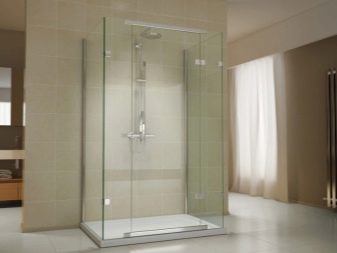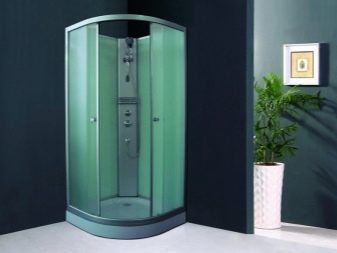Shower cabin without a roof
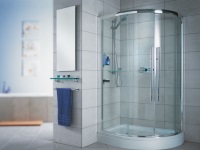
Until quite recently - 10-20 years ago - shower cabins were installed mainly in the toilets of public institutions: hospitals, hotels, gyms, etc. Own apartments and houses owners preferred to equip only with baths. Today the shower cabin is considered a convenient and functional device, which can almost become a full substitute for the bath.
A large choice of shower cabins allows you to choose a unit for any bathroom and for any needs. In sanitary ware stores there are square and round shower cabins, with deep and shallow trays, combined with a bath and sauna. One of the most popular models is a shower cabin without a roof.
Shower enclosure, equipped only with a tray and partitions, is called open. Such a modification is considered budgetary and therefore available to a large number of buyers.

Pros
- As mentioned above, open shower cabins in the masses are much cheaper than sealed models. Therefore, if the budget does not allow to buy a cabin-capsule, it is worth stopping at this option.
- Because of the low price, open showers have a fairly simple configuration. This means that their installation requires much less time, effort and special knowledge than the installation of sealed showers.
- The minimum height of shower cabins with a roof is 205 cm. That is, in rooms where the ceiling height is less than this figure, it is impossible to install an enclosed shower cabin. Meanwhile, quite often shower cabins are bought to install in villas or on the attic floor, where the ceilings are very low or have a slope. Open showers tend to be slightly lower, so they can be easily placed even in the bathroom with the lowest ceiling.
- Another advantage is related to the height of the shower enclosure users. Tall people often feel uncomfortable in enclosed cabins, where the ceiling is only a few inches from the head. In this case, the shower cabin will be an excellent solution to the problem.
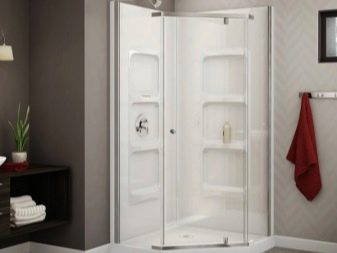
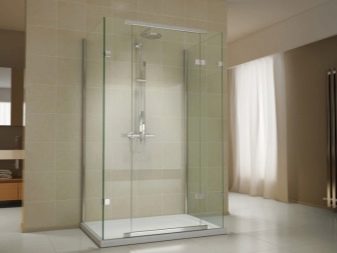
Disadvantages
- The main disadvantage of open shower cabins is that their use is impossible if the bathroom is not properly waterproofed. Steam escaping through the top of the cabin settles on the ceiling, walls and furniture. If the finishing materials are not moisture-resistant, it will soon lead to the loss of appearance, the formation of mold and the appearance of insects.
- Since outdoor shower cabins are considered as an option for a limited budget, manufacturers often save on the quality of materials and components. To purchase reliable and durable equipment, you should turn only to the tried and trusted manufacturers.
- Because of the design features, the open models of shower cabins have a limited set of functions. For example, they can not be used for sessions of the steam bath or sauna, and the shower cabins with a roof often buy just for this purpose.

Types of shower trays
Just like the closed models, shower cabins without a roof may be equipped with trays of different depths. Some models are sold without trays at all - it is assumed that it can be made by yourself.
Deep trays - These are trays, the height of which is up to 30 cm. They are often chosen by those who are used to using the bathtub, because if you fill a deep tray with water, it turns into a kind of "trough" in which you can bathe a child or wash small things.
low trays - This tray is less than 15 cm in height. They are often purchased in homes where the elderly or people with disabilities live. Experts do not recommend installing a shallow tray, if the water drain in the bathroom does not work well. Otherwise, there is a high probability of flooding the neighbors.
Trays with a height of 15 to 30 cm are considered medium. They are chosen by those who have no special requirements regarding the depth of the tray.
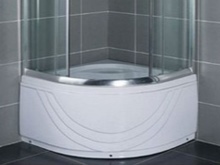
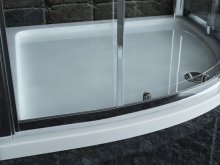
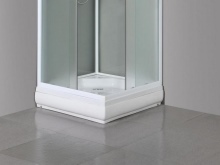
Popular sizes
The size of shower trays can be very different, because in addition to the standard square and rectangular models, showers are sold with round, oval and asymmetrical trays.
We will consider the most common sizes:
- 80*80 - The smallest shower cabins, which are usually installed in cramped closet bathrooms; in width they just match the space freed up after the removal of the bathtub;
- 90*90 - one of the most popular options, because it is more spacious than the previous one, but not as expensive as the shower cabins of meter width; they allow you to take a shower with comfort, but do not take up much space.
- 100*100 - the best option in terms of convenience, because it allows you to take a shower without problems, even a fairly large person; such cabins are usually installed in spacious bathrooms;
- 80*120 - large models, which take up as much space as a standard bathtub; usually equipped with many additional features and a comfortable seat.

Choosing Tips
- Going to buy a shower cabin must decide in advance on its basic parameters: size, shape, depth of the tray and fabrication material.
- If you own a small bathroom, then look at angular models. Such a shower cabin will free up some useful space.
- When buying pay attention to the thickness of the walls - the thicker the wall, the better. Do not buy a cabin with a thickness of the walls of less than 6 mm. Also carefully inspect the walls and doors for chips, scratches and other mechanical damage.
- Choosing a shower enclosure, open-close the door of the model you like several times. If the product is of high quality, the opening-closing of the doors should be silent and without effort.
- Check the completeness of the shower enclosure. Since models without a roof are usually inexpensive, manufacturers can save on equipment. You can buy all the necessary accessories separately.
